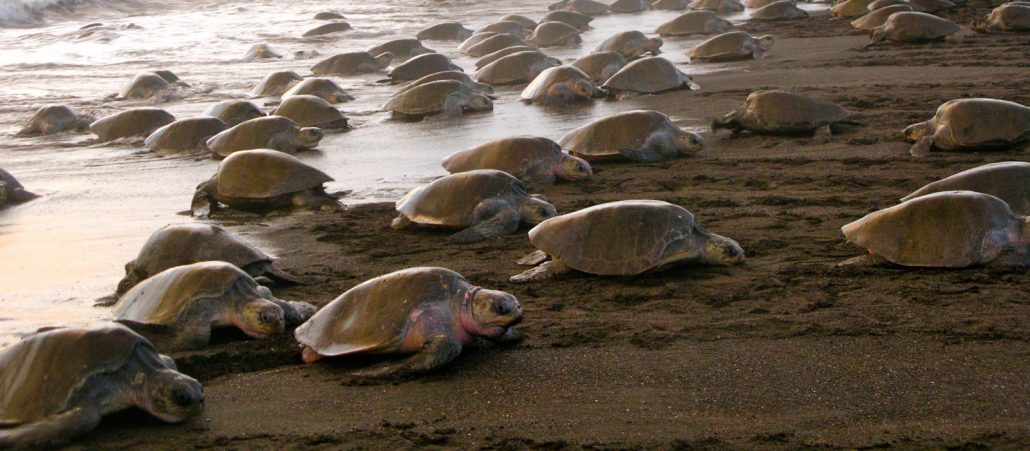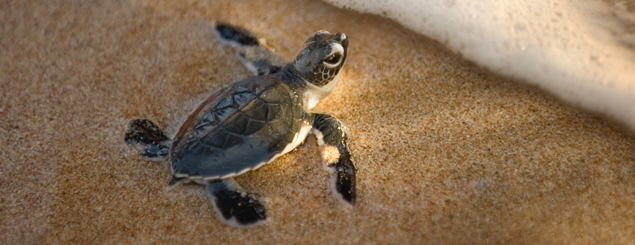When was the last time you visited one of the world's most important anythings? Welcome to Ostional Wildlife Refuge which, according to the World Wildlife Fund, is "one of the two most important areas in the world for nesting of the olive ridley turtle." Indeed, this is the place for nearly guaranteed Costa Rica turtle watching. The place in the world, specifically.
Every year, millions of sea turtles lumber onto the beaches of Ostional National Wildlife Refuge. Every year, millions of sea turtles are born on the beaches of Ostional Wildlife Refuge. And every year, thousands of lucky visitors come to these beaches to witness this spectacular event.
And it's not just that. While olive ridley turtles (Lepidochelys olivacea) are most common at Ostional – up to 150,000 (yes, you read that right!) can come ashore during a single nesting event – leatherback sea turtles (Dermochelys coriacea) and Pacific green turtles (Chelonia mydas agassizii) are also known to nest here.

While we're on the topic of eggs, let's talk nesting. And you can't talk olive ridley nesting, without discussing arribadas, aka mass arrivals. When it comes to Costa Rica turtle watching, "arribada" is the magic word. And, in fact, it's almost a guarantee, in a natural world that delivers few guarantees. Olive ridley turtle nest two to six times a year. (That's per individual, not total nesting events a year.) What's more, they often nest en masse– even into the range of tens and hundreds (!) of thousands of nesting sea turtles. (At Ostional, 150,000 nesting turtles is not an uncommon number.) Here at Ostional, arribadas peak from June to December, with the highest peaks in September and October. There are nesting events during the dry season months – at least one a month, January through May – but they see fewer mother turtles. Fun fact #3: In November 1995, Ostional registered its largest-ever arribada: 500,000 nesting females came ashore! Leading up to each arribada, we often notice huge numbers of turtles off the beach – sometimes, hundreds of miles off the beach. That's because olive ridleys mate in open waters, throughout the year, but will not nest until an arribada is triggered. Though scientists aren't exactly sure what triggers an arribada, many experts believe a waxing moon in its last quarter will do the trick. Long story short: If you're trying to time a visit, your best bet is July through December, between a three-quarter and full moon. (See more about this below: When to Visit Ostional Wildlife Refuge.) An arribada begins with a few hundred turtles and then, over the course of a few days, quickly ramps up to thousands of turtles on the beach, every night. Arribadas typically last 3-5 days, although they can extend to 7 days. All this boils down to one hard fact: Ostional Wildlife Refuge offers one of the only "guaranteed" sea turtle nesting events, year-round. Bottom line: You're likely to spot turtles here. In the unpredictable world of Mother Nature, this is as close as it comes to a sure thing. As we said, this is the place for Costa Rica turtle watching.
Costa Rica turtle watching tours to Ostional are available year-round, with a definite high season (high season, as turtles go; note this is the low season for Costa Rica travel) preference in August, September, and October. Witnessing turtle nesting can be a wonderful and moving experience. Be sure to book your tour with a reputable operator, preferably one that works with the Local Guides Association. A guide is absolutely required throughout your entire visit and profits are invested back into the community, the association, and environmental protections. Note that dark clothes are recommended, as they will not disturb the nesting mothers. If you're staying with us, Cris, our onsite (and free!) concierge will be happy to arrange a turtle tour for you.
Alert, alert! As of this post (September 2018), it's high turtle season and we're experiencing one of the largest arribadas of the year.So, who's ready for some Costa Rica turtle watching?
Ostional Wildlife Refuge At-A-Glance:
Location: 65 miles south of Tamarindo Founded: 1982 (declared a protected area) and 1984 (refuge formed) Maximum Altitude: Sea level Area: 180 acres; the refuge is part of the greater Tempisque Conservation Area (= tens of thousands of protected acres) Hours: 8 a.m. to 4 p.m. Telephone: 2682-0470 Entrance Fee: $15 adults / $5 childrenSmall but Mighty: Olive Ridley Turtles
The olive ridley sea turtle (Lepidochelys olivacea) is the smallest of the world's seven sea turtle species, measuring about two feet in diameter and weighing in at 60 to 110 pounds. ("Small" is clearly a relative term, when it comes to the ocean's turtles.) Their lifespan is unknown, but estimated around 50 years in the wild. Once classified as critically endangered and then endangered, today both the International Union for Conservation of Nature (IUCN) and the U.S. Federal Endangered Species Act olive ridley turtles as a threatened species. True to name, these mighty creatures range in color from charcoal gray (juveniles) to a dark green-gray (adults). Males have longer and thicker tails, which, when seen in the open ocean, you can spot sticking out beyond their carapace. Olive ridleys are technically omnivores, though their preferences swing solidly into the carnivore column: fish, mollusks, crustaceans, and even jellyfish, if the mood strikes. When food is scarce, they will snack on algae. Fun fact #1: Unlike many turtle species, olive ridleys are not strictly "beach loyal;" while they exhibit some fidelity to their natal beaches, they may or may not nest there. Fun fact #2: Temperature determines sex. When eggs incubate at 87.8-89.6º F, they mature into females; eggs that incubate at a cooler 84.2-86º F mature into males.Back up! What's an "Arribada"?

While we're on the topic of eggs, let's talk nesting. And you can't talk olive ridley nesting, without discussing arribadas, aka mass arrivals. When it comes to Costa Rica turtle watching, "arribada" is the magic word. And, in fact, it's almost a guarantee, in a natural world that delivers few guarantees. Olive ridley turtle nest two to six times a year. (That's per individual, not total nesting events a year.) What's more, they often nest en masse– even into the range of tens and hundreds (!) of thousands of nesting sea turtles. (At Ostional, 150,000 nesting turtles is not an uncommon number.) Here at Ostional, arribadas peak from June to December, with the highest peaks in September and October. There are nesting events during the dry season months – at least one a month, January through May – but they see fewer mother turtles. Fun fact #3: In November 1995, Ostional registered its largest-ever arribada: 500,000 nesting females came ashore! Leading up to each arribada, we often notice huge numbers of turtles off the beach – sometimes, hundreds of miles off the beach. That's because olive ridleys mate in open waters, throughout the year, but will not nest until an arribada is triggered. Though scientists aren't exactly sure what triggers an arribada, many experts believe a waxing moon in its last quarter will do the trick. Long story short: If you're trying to time a visit, your best bet is July through December, between a three-quarter and full moon. (See more about this below: When to Visit Ostional Wildlife Refuge.) An arribada begins with a few hundred turtles and then, over the course of a few days, quickly ramps up to thousands of turtles on the beach, every night. Arribadas typically last 3-5 days, although they can extend to 7 days. All this boils down to one hard fact: Ostional Wildlife Refuge offers one of the only "guaranteed" sea turtle nesting events, year-round. Bottom line: You're likely to spot turtles here. In the unpredictable world of Mother Nature, this is as close as it comes to a sure thing. As we said, this is the place for Costa Rica turtle watching.
Sea Turtle Hatching at Ostional Wildlife Refuge
Where there is sea turtle nesting, there is sea turtle hatching! As stated above, females typically nest two to six times per year, laying clutches of 100+ eggs each time. Olive ridley sea turtle eggs incubate an average 52-58 days. And, since nesting turtle visit these beaches year-round, their eggs hatch year-round, too. The timing of hatching events is a little tougher to pinpoint than that of an arribada, but if you're in town about 45-50 days after the last full moon, you have a good shot of spotting tiny turtle hatchlings, making their way to the sea. Note: Very likely, hatching is not as sweet a moment as you're imagining. The harsh reality is that wild animals – coatis, caimans, raccoons, coyotes, and more – often pillage olive ridley nests, gobbling up the eggs before they can mature. Of the eggs that do mature, many hatchlings die on their journey from beach to sea – prey to crabs, iguanas, vultures, and other hungry animals. Finally, once in the ocean, they serve as tasty snacks for fish, crocs, and sharks. The odds are harsh but, for those that do survive, the remainder of their lives is lived in relative peace. Adult olive ridleys have very few predators.When to Visit Ostional Wildlife Refuge
When it comes to Costa Rica turtle watching, you can't go wrong at Ostional. As we mentioned earlier, you have a decent chance of spotting olive ridleys year-round. That said, you'll boost your chances – and see many, many more nesting mothers – if you visit during the peak season of July through December. Better your already great odds, and visit in September and October. Notably, leatherback (Dermochelys coriacea) and Pacific green turtles (Chelonia mydas agassizii) also nest – in much few numbers – from October through January.Ostional Wildlife Refuge Turtle Tours

Costa Rica turtle watching tours to Ostional are available year-round, with a definite high season (high season, as turtles go; note this is the low season for Costa Rica travel) preference in August, September, and October. Witnessing turtle nesting can be a wonderful and moving experience. Be sure to book your tour with a reputable operator, preferably one that works with the Local Guides Association. A guide is absolutely required throughout your entire visit and profits are invested back into the community, the association, and environmental protections. Note that dark clothes are recommended, as they will not disturb the nesting mothers. If you're staying with us, Cris, our onsite (and free!) concierge will be happy to arrange a turtle tour for you.


